The Eurasian Invasion - the Latin's
 When last we left Etruria, we were mystified by the Etruscan's policy of not helping each other when faced with a common threat. This incredible policy would of course, have devastating effects. Moving ahead to perhaps 1100 B.C. It is at about this time, that people from the Eurasian plains called "the Latin's" later known as the Romans - migrate in. These Latins may have accompanied the Hellenes into Greece, and then continued on into Italy. The nature of the early contact between the two peoples, is unknown. But, the later relationship is well known to be one of violence.
When last we left Etruria, we were mystified by the Etruscan's policy of not helping each other when faced with a common threat. This incredible policy would of course, have devastating effects. Moving ahead to perhaps 1100 B.C. It is at about this time, that people from the Eurasian plains called "the Latin's" later known as the Romans - migrate in. These Latins may have accompanied the Hellenes into Greece, and then continued on into Italy. The nature of the early contact between the two peoples, is unknown. But, the later relationship is well known to be one of violence.Soon after the invasion of Whites from Eurasia began, a coalition of the original Black inhabitants of Italy, Greece and the Aegean area, formed a conglomeration called the "Sea People". They boarded ships with all of their belongings and fled the area. But those that stayed behind, still had to deal with the White newcomers.
| For more on the Sea People: Click here >>> |
Were the original Romans Black People?
 |
Were the original Romans Black People? As we have shown on many pages, all of those marble statues and busts of "Supposed" White Greeks and Romans, that we find in museums today, are really 1600-1800s fabrications. White history is so replete with lies and fake artifacts, that it would be impossible for this, or any other "Truth Seeking" publication, to investigate every possibility. So for convenience, we will not delve into this founding of Rome, as documented in the Aeneid. But rather, will work with the conventional story. | |||
The AeneidThe Aeneid is a Latin epic poem written by Virgil in the late 1st century BC (70–19 B.C.) that tells the legendary story of Aeneas, a Trojan who traveled to Italy, where he became the ancestor of the Romans. It is composed of roughly 10,000 lines in dactylic hexameter.The first six of the poem's twelve books tell the story of Aeneas's wanderings from Troy to Italy, and the poem's second half tells of the Trojans' ultimately victorious war upon the Latins (Whites), under whose name Aeneas and his Trojan followers are destined to be subsumed. The hero Aeneas was already known to Greco-Roman legend and myth, having been a character in the Iliad; Virgil took the disconnected tales of Aeneas' wanderings, his vague association with the foundation of Rome and a personage of no fixed characteristics other than a scrupulous piety, and fashioned this into a compelling founding myth or nationalist epic that at once tied Rome to the legends of Troy, glorified traditional Roman virtues and legitimized the Julio-Claudian dynasty as descendants of the founders, heroes and gods of Rome and Troy.
| |||
The reason the poem is important, is because the Trojans were Phrygian's - and this is what the Phrygian king Midas looked like.
And this is how Etruscans depicted the Trojans (the guy on the ground).
| |||
Quote: Although it was commissioned by the Emperor Augustus, the poem is more than early imperial propaganda. It proclaims the divine mission of Aeneas to found Rome and the divine injunction of the Romans to unite the world under a noble Emperor such as Augustus.As a logical matter then, why would the Romans tolerate, much less enthusiastically accept (the Aeneid was very popular), a founding story that gives credit to Blacks for the nations creation, if they (the elites), themselves were not Black?The other inescapable conclusion, is that the Emperor Augustus was himself Black. In which case, we can chalk this statue up, to the same people as "The Dying Gaul" statue. With it being nothing more than "Pure White fantasy" probably done in the 1600-1700s.
From Wiki Augustus of Prima Porta (Italian: Augusto di Prima Porta) is a 2.04m high marble statue of Augustus Caesar which was discovered on April 20, 1863, in the Villa of Livia at Prima Porta, near Rome. Augustus Caesar's wife, Livia Drusilla, retired to the villa after his death. The sculpture is now displayed in the Braccio Nuovo of the Vatican Museums.The dating of the Primaporta piece is widely contested. It is thought to be a marble copy of a possible bronze original. This original, along with other high honors, was devoted to Augustus by the Senate in 20 B.C, and set up in a public place. Up until this time Augustus had lived modestly, but the fact that the statue was found in his widow's villa shows that he was thoroughly pleased with it. It is also contested that this particular sculpture is a reworking in marble of a bronze original, possibly a gift from Tiberius Caesar to his mother Livia (since it was found in her villa Ad Gallinas Albas in the vicinity of the ninth marker of the via Flaminia, and close to a late Imperial gate called Prima Porta) after Augustus' death and in honor of the woman who had campaigned so long for him to become the next Caesar. This would explain the divine references to Augustus in the piece, notably his being barefoot, the standard representation of gods or heroes in classical iconography. Also, the reliefs in the cuirass depict the retrieval of Crassus' standards captured by the Parthians, an event in which the young Tiberius himself took a part, serving as intermediary with the Parthian king, in the act that is shown in the central scene of the armor, possibly his grandest service to his adopted father Augustus. With the introduction of Tiberius as the figure responsible for the retrieval of the standards, he associates himself with Augustus, the emperor and the new god, as Augustus himself had done previously with Julius Caesar. Under this hypothesis, the dating of the statue can be placed during the first years of Tiberius' reign as emperor (14 — 37 A.D.). |
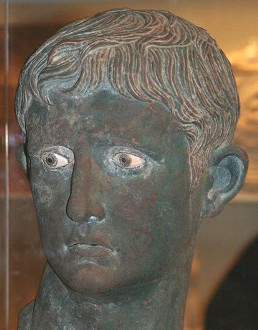 As a further demonstration of the problems Whites have with the actual race of Augustus: there is the matter of this statue head "Supposedly" Discovered at Meroe in 1910 by J. Garstang. Based on accounts of the Roman wars with Meroe in Strabo's Geography, circa 22 A.D. It was decided that it was the head from one of the many giant statues of Augustus, which were scattered all over Egypt. Aside from that absurdity, of which there is no evidence, the statue head of course, has no inscription. Like Herodotus, Strabo wrote entertainment in the guise of history. His accounts of the wars is obviously fanciful, and to use that type of material to make historical judgments, is a clear indication of the fragility of White history.
|
In time, the Romans had learned how to built cities, now there is great competition for power and territory. Wars rage, but the Etruscan cities fight alone, and the Romans can simply attack and annex each individual city; divide and conquer was the order of the day. This disunity is further illustrated by the fact that the Romans concluded treaties with individual Etruscan city/states, rather than the whole.
But the Etruscans reemerged as a local power during 800 - 700 B.C, spreading their trade to Corsica, Sardinia and Iberia and creating a powerful navy to guard their interests. The Phoenicians and Etruscans became trading partners and rivals, exchanging goods and opportunistic raids with each other. However the situation changed after the "Whites" of Greece, had consolidated power and began to expand into the Western Mediterranean at about 750 B.C.}
In approximately 600 B.C, the Etruscans attacked and occupied the area of Latium and settled themselves in the city of Rome, from here the influence of Etruscan civilization and art made itself felt in the entire Latin sphere.
But their expansion soon collided with that of the Greeks, especially in the sixth century B.C, when Phoceans (Greeks in Italy) founded colonies along the coast of France, Catalonia and Corsica. This led the Etruscans to ally themselves with the Carthaginians (Phoenicians), whose interests also collided with the Greeks.
{Note: The Phoenicians had planted trading posts in Africa, Sicily, Sardinia and Iberia during 1100-900 B.C. while creating their trading monopoly. They had a relatively free hand during that period as other civilizations were suffering from a "Dark Age" during that period because of the invasion of Whites from Eurasia.


In 540 B.C, at the Battle of Alalia; which took place off the coast of Corsica, between Phocaeans and allied Etruscans and Carthaginians. The Punic-Etruscan fleet of 120 ships defeated the Greek force of sixty ships and the nearby colony of Alalia (now Aléria) was taken over by the Etruscans. Corsica was shared by the Carthaginians and Etruscans, and Carthage retained Sardinia.
This led to a new distribution of power in the western Mediterranean Sea. Though the battle had no clear winner, Carthage managed to expand its sphere of influence at the expense of both the Etruscans and the Greeks, and Etruria saw itself relegated to the northern Tyrrhenian Sea. From the first half of the fifth century, the new international political situation meant the beginning of the Etruscan decline after losing their southern provinces. |
As Caucasians kept coming in, Rome soon became a large city, similar to the powerful cities of southern Etruria, and it had also become predominately Caucasian. Accordingly, it was a Caucasian uprising that drove the Etruscans from Rome in 509 B.C.
In 480 B.C, Etruria's ally Carthage, was defeated by a coalition of Magna Graecia (the Greek colonized zone encompassing Sicily and Southern Italy) cities led by Syracuse. Later, it was a coalition of Caucasians - Latin’s and the "new" Greeks, that led to the Etruscans' withdrawal from the whole of Latium in 475 B.C.
A year later, in 474 B.C, Syracuse's tyrant Hiero, defeated the Etruscans at the Battle of Cumae. Later, Etruria saw a Gallic (Celtic - see next page for more on the Gauls/Celts) invasion end its influence over the Po valley and the Adriatic coast. Meanwhile, Rome had started annexing Etruscan cities. This first led to the loss of their north provinces.
The Etruscans continued to decline, until finally Etruria was incorporated into Rome. Over time the Etruscans ceased to exist as a separate people, and they along with their culture and technology were totally absorbed into Rome. However, it should be pointed out, that if Etruscan Tomb Paintings are any indication, absorption by the Latin's was not unduly traumatic.
Once again, we must as the question: "Were the original Romans and Greeks Black People?" Please consider: aside from the marble statues and busts (which we know to be 1600-1800s creations), which depict them as Whites. And the constant bombardment of White media; such as Books, Movies, and Television, which serves to "Condition" us to the concept - What evidence is there really that these people were White?Certainly there can be no argument that Whites eventually took over. The question is "Which" Whites, and When? When we cast aside all of those fake marble Statues and Busts, and rely on only the authentic artwork which was done by the people themselves, in their own ancient times, we see a very different story of ancient Greece and Rome.Below are pictures of authentic ancient artwork, and links to more: When we look at them, something very revealing is instantly apparent: the main subjects and owners of the tombs, were all Black people - as were the "Gods". If all of the wealthy "Elites" and Gods, were Black people, what does that tell us about the nature of these ancient societies? |
Etruscan Tomb Painting |
 |
| To see Etruscan Tomb Paintings Click Here>> |
later history relates that some Etruscans lived in the Tuscus vicus, the “Etruscan quarter”, and that there was an Etruscan line of kings (albeit ones descended from a Greek, Demaratus the Corinthian) which succeeded kings of Latin and Sabine origin.

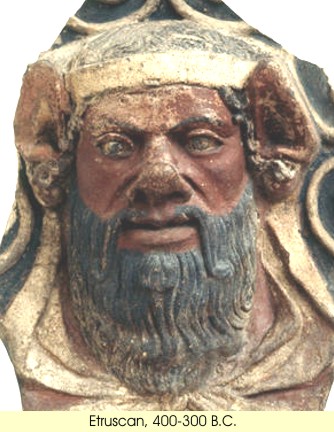
Pompeii
The city of Pompeii is a partially buried Roman town-city near modern Naples in the Italian region of Campania, in the territory of the comune of Pompei. The name “Pompeii” in Latin is a second declension plural (Pompeii, -orum). According to Theodor Kraus, “The root of the word Pompeii would appear to be the Oscan word for the number five, pompe, which suggests that either the community consisted of five hamlets or, perhaps, it was settled by a family group (gens Pompeia).” Along with Herculaneum, its sister city, Pompeii was destroyed and completely buried during a long catastrophic eruption of the volcano Mount Vesuvius spanning two days in 79 AD.
 |
Erotic art in Pompeii and Herculaneum was discovered in the ancient cities around the bay of Naples (particularly of Pompeii and Herculaneum) after extensive excavations began in the 18th century. The city was found to be full of erotic art and frescoes, symbols, and inscriptions regarded by its excavators as pornographic.
| Click Here for more Pompeii frescoes (Caution: some are of a pornographic nature). Click Here >>> |
Pompeii Wall mural of Mercury/Priapus - between 89 B.C. and 79 A.D. |
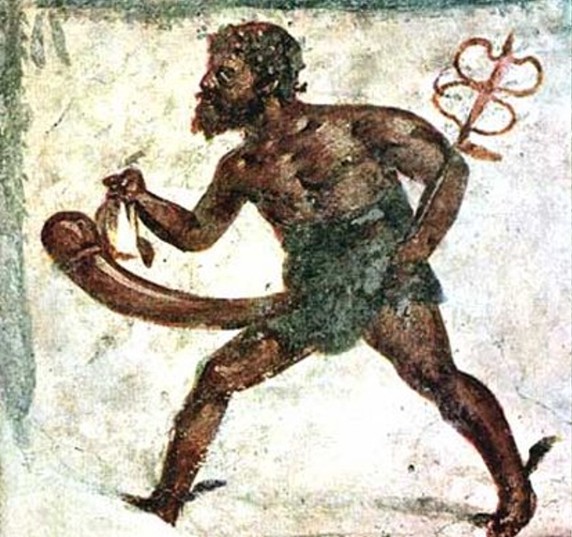 |
The Celts/Gaul's
By the end of the ancient era (B.C.), new invaders had migrated into western Europe from the east; and pushed the remaining indigenous peoples south. These new people were mainly Celts, who had been pushed out of their central European lands by the invading White Germanic tribes.
By now, the original people had accepted rule of the conquering Romans, though the acceptance was uneasy. As would be expected, there was almost constant warfare between these two peoples, the western Celts known as Gaul's, and the eastern Celts. But their hatred of each other was less than their hatred of Roman rule. There were many rebellions against Rome by both groups. As we can see from Julius Caesar's comments below; Gaul's and Celts were the same people. As with all the ancient people of Europe, modern racists have sought to portray them as White people. The famous marble statue "The Dying Gaul" is a fake, just as is the statue of Vercingetorix that was put up by Napoleon III in 1865. See photo below.
| As we have said and demonstrated many times: modern Whites have institutionalized the falsification of history. Even their translations of ancient texts and historians, cannot be trusted. However, sometimes a bit from one place, coupled with a bit from another place, yields the truth. In "THE HISTORY OF COUNT ZOSIMUS" circa 500 A.D. Sextus Julius Saturninus (the governor of Syria) is described as a Moor. In other texts, he is described as a Gaul. Such interchangeability of description, would not be possible if Gaul's and Moors were not the same thing: Black People! |
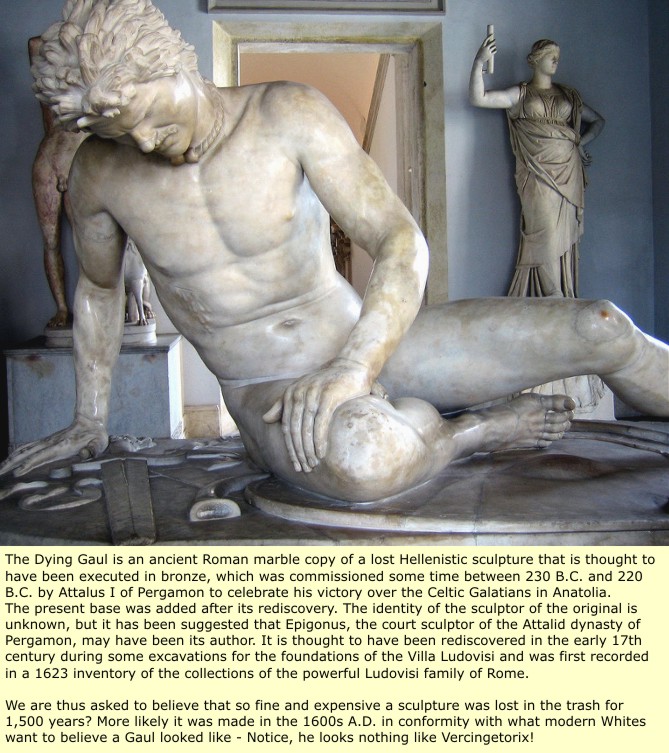 |
| Strangely; the statue "The Dying Gaul" does seem to be in exact conformity with the "Supposed" description of "Diodorus Siculus" who is said to describe them as such: “The Gauls are tall in body, with rippling muscles... They are always washing their hair in limewater and pull it back from the forehead... , so that that they look like Satyrs and Pans; the treatment of their hair makes it so heavy and coarse that it looks like the mane of a horse... some of them shave the beard, but others let it grow a little. The nobles shave their cheeks but let the mustache grow until it covers the mouth". Click here for more "Supposed" ancient comments and their true worth. |
Julius Caesar, in his book, Commentarii de Bello Gallico - ca. 50 B.C, comments:
All Gaul is divided into three parts, one of which the Belgae inhabit, the Aquitani another, those who in their own language are called Celts, in ours Gauls, the third. All these differ from each other in language, customs and laws. The Garonne River (roughly divides France and Spain) separates the Gauls from the Aquitani; the River Marne (runs east and southeast from Paris) and the River Seine separate them from the Belgae. Of all these, the Belgae are the bravest, because they are furthest from the civilisation and refinement of (our) Province, and merchants least frequently resort to them, and import those things which tend to effeminate the mind; and they are the nearest to the Germani, who dwell beyond the Rhine (runs north from eastern Switzerland through Germany and the Netherlands to its two-pronged outlet on the North Sea), with whom they are continually waging war.For which reason the Helvetii also surpass the rest of the Gaul's in valour, as they contend with the Germani in almost daily battles, when they either repel them from their own territories, or themselves wage war on their frontiers. One part of these, which it has been said that the Gauls occupy, takes its beginning at the River Rhone; it is bounded by the Garonne River, the Atlantic Ocean, and the territories of the Belgae; it borders, too, on the side of the Sequani and the Helvetii, upon the River Rhine, and stretches toward the north. The Belgae rises from the extreme frontier of Gaul, extend to the lower part of the River Rhine; and look toward the north and the rising sun. Aquitania extends from the Garonne to the Pyrenees and to that part of the Atlantic (Bay of Biscay) which is near Spain: it looks between the setting of the sun, and the north star.
Note: The Helvetii, refers to a conglomeration of Celtic tribes formed by the Helvetian's of southern Germany and numbering in excess of 300,000, who decided to flee the invading White Germanic tribes.
Vercingetorix
 One of the last, or perhaps the last, of the original Black civilizations to be destroyed by the Whites, were the Arverni of southern France. They were an advanced culture who lived in cities and were wealthy in gold and silver, (as attested to by the huge booty taken from them by the Romans).
One of the last, or perhaps the last, of the original Black civilizations to be destroyed by the Whites, were the Arverni of southern France. They were an advanced culture who lived in cities and were wealthy in gold and silver, (as attested to by the huge booty taken from them by the Romans).Their demise came about because of a revolt against Rome by another Black Gaul city called "Carnutes". In early 52 B.C, Carnutes used the turmoil that accompanied the death of Publius Clodius Pulcher; a Roman politician, as an opportunity to rebell; they slaughtered all of the Romans in their territory.
Seeing this, "Vercingetorix" a young nobleman of the Arvernian capital city of Gergovia, moved to join the rebellion. He was however rebuffed by the nobles of Gergovia, forcing him to raise an army in the countryside. He then returned to Gergovia and took the city, whereupon he was declared king.
In most historical accounts, it is said that Vercingetorix unified ALL of the Gaul's under his command. In his campaign against Julius Caesar, Vercingetorix was at first successful, but over time, the tide began to turn. The end came at the Battle of Alesia, the capital city of another of the Black Gaul people, the Mandubii.
At Alesia, Vercingetorix made his last stand. Caesar instead of making a direct assault, surrounded the city with fortifications in order to starve them out. When Vercingetorix sent for reinforcements, Caesar built another set offortifications to his rear, to hold back the reinforcements. When the reinforcements arrived, they were of insufficient number to break through Caesars line. After many loosing battles to break out, Vercingetorix was forced to mount his horse, ride out and surrender to Caesar.
Vercingetorix was taken prisoner and imprisoned in the Tullianum in Rome for five years, before being publicly displayed in Caesar's triumph in 46 B.C, after which he was executed. Gergovia, Alesia, and all the other Black Gaullic cities were destroyed. It is estimated that one million persons died in the wars, and another million were sold into slavery; at the end, Caesar had effected an unprecedented genocide. The destruction was so complete, that at this time, the only known evidence of their existence is Roman coins, (such as the one above), and written Roman accounts.
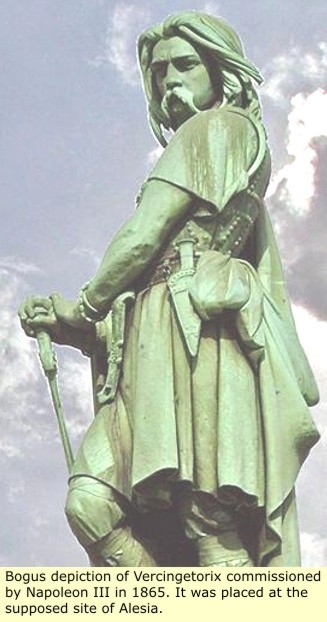 |
Ancient references to the Celts/Gauls
The first literary reference to the Celtic people, as (Κeltoi) is by the Greek historian Hecataeus of Miletus in 517 B.C; he locates the ''Keltoi'' tribe in Rhenania (West/Southwest Germany). The next Greek reference to the ''Keltoi'' is by Herodotus in the mid 5th century B.C. He says that "the river Ister (Danube) begins from the ''Keltoi'' and the city of Pyrene and so runs that it divides Europe in the midst (now the ''Keltoi'' are outside the Pillars of Heracles (Rock of Gibraltar) and border upon the Kynesians, who dwell furthest towards the sunset (West) of all those who have their dwelling in Europe)".According to Greek mythology, (''Celtus'') was the son of Heracles and (''Keltine''), the daughter of (''Bretannus''). Celtus became the eponymous ancestor of Celts. In Latin ''Celta'' came in turn from Herodotus' word for the Gauls, ''Keltoi''. The Romans used ''Celtae'' to refer to continental Gauls, but apparently not to Insular Celts. The latter were long divided linguistically into Goidhels and Brythons, although other research provides a more complex picture. Another complication is that in the case of the Romans, Gaul (Latin Gallia) is a historical name used in the context of the Roman Empire in references to the region of Western Europe approximating present day France and Belgium, but also sometimes including the Po Valley, western Switzerland, and the parts of the Netherlands and Germany on the west bank of the River Rhine.
In the third century B.C, Gauls immigrated from Thrace into the highlands of central Anatolia (modern Turkey). These people, called Galatians, later merged with the local population but retained many of their own traditions. The Galatia became its ruling caste in the 3rd century B.C. It has been called the "Gallia" of the East, Roman writers calling its inhabitants Galli. St. Jerome states that as of the fourth century A.D. their language was similar to that of the Treveri. This language is in fact German. (The Romans called all people between the Pyrenees and the Rhine Gauls. The word 'Gaul' didn't imply a specific language).
The German Celts were great warriors, respected by Greeks and Romans. They hired themselves out as mercenary soldiers, sometimes fighting on both sides in the great battles of the times. For years the chieftains and their war bands ravaged the western half of Asia Minor, as allies of one or other of the warring princes, without any serious check, until they sided with the renegade Seleucid prince Antiochus Hierax, who reigned in Asia Minor. Hierax tried to defeat king Attalus I of Pergamum (241–197 B.C.), but instead, the hellenised cities united under his banner, and his armies inflicted several severe defeats upon them, about 232 forcing them to settle permanently and to confine themselves to the region to which they had already given their name. The theme of the ''Dying Gaul'' (a famous statue displayed in Pergamon) remained a favorite in Hellenistic art for a generation. Their right to the district was formally recognized. The three Celtic tribes were settled where they afterwards remained, the Tectosages round Ancyra, the Tolistobogii round Pessinus, sacred to Cybele, and the Trocmi round Tavium.
Diodorus Siculus and Strabo both suggest that the Celtic heartland was in southern France. The former says that the Gauls were to the north of the Celts but that the Romans referred to both as Gauls. Before the discoveries at Hallstatt and La Tene, it was generally considered that the Celtic heartland was southern France, see Encyclopedia Britannica for 1813.
The Celts also expanded down the Danube river and its tributaries. One of the most influential tribes, the Scordisci , had established their capital at Singidunum in 3rd century BC, which is present-day Belgrade , Serbia . The concentration of hill-forts and cemeteries shows a density of population in the Tisza valley of modern-day Vojvodina , Serbia , Hungary and into Ukraine . Expansion into Romania was however blocked by the Dacians .
Further south, Celts settled in Thrace ( Bulgaria ), which they ruled for over a century, and Anatolia , where they settled as the Galatians (see also: Gallic Invasion of Greece ) . Despite their geographical isolation from the rest of the Celtic world, the Galatians maintained their Celtic language for at least seven hundred years. St Jerome , who visited Ancyra (modern-day Ankara ) in 373 AD, likened their language to that of the Treveri of northern Gaul.
The Boii tribe gave their name to Bohemia , Bologna and possibly Bavaria , and Celtic artefacts and cemeteries have been discovered further east in what is now Poland and Slovakia . A celtic coin ( Biatec ) from Bratislava 's mint is displayed on today's Slovak 5 crown coin.
As there is no archaeological evidence for large scale invasions in some of the other areas, one current school of thought holds that Celtic language and culture spread to those areas by contact rather than invasion. However, the Celtic invasions of Italy and the expedition in Greece and western Anatolia , are well documented in Greek and Latin history. There are records of Celtic mercenaries in Egypt serving the Ptolemies. Thousands were employed in 283-246 B.C. and they were also in service around 186 BC. They attempted to overthrow Ptolemy II. It had been known for long time that there was an early Celtic (Lepontic, sometimes called Cisalpine Celtic) presence in Northern Italy since inscriptions dated to the sixth century B.C. have been found there.
The site of Golasecca, where the Ticino exits from Lake Maggiore, was particularly suitable for long-distance exchanges, in which Golaseccans acted as intermediaries between Etruscans and the Halstatt culture of Austria, supported on the all-important trade in salt.
In 391 B.C. Celts "who had their homes beyond the Alps streamed through the passes in great strength and seized the territory that lay between the Appennine mountains and the Alps" according to Diodorus Siculus. The Po Valley and the rest of northern Italy (known to the Romans as Cisalpine Gaul) was inhabited by Celtic-speakers who founded cities such as Milan. Later the Roman army was routed at the battle of Allia and Rome was sacked in 390 B.C. by the Senones. At the battle of Telamon in 225 B.C. a large Celtic army was trapped between two Roman forces and crushed.
The defeat of the combined Samnite, Celtic and Etruscan alliance by the Romans in the Third Samnite War sounded the beginning of the end of the Celtic domination in mainland Europe, but it was not until 192 B.C. that the Roman armies conquered the last remaining independent Celtic kingdoms in Italy. The Celts settled much further south of the Po River than many maps show. Remnants in the town of Doccia, in the province of Emilia-Romagna, showcase Celtic houses in very good condition dating from about the 4th century B.C.
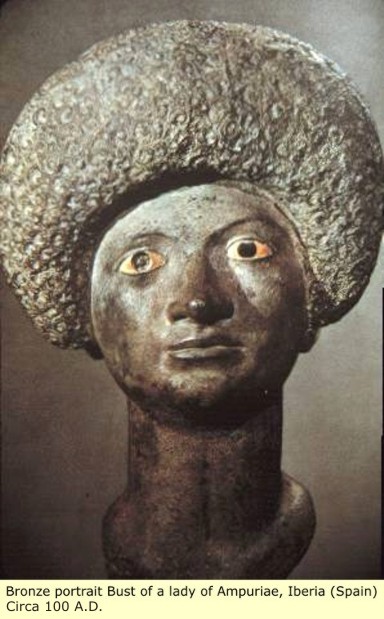 |
Rome would continue to grow, and in time it would come to absorb the classical Greek civilization as well. As Rome extended its influence and presence throughout the Mediterranean world, it encountered and absorbed deities and religious practices of those it encountered. Attempts were made periodically to suppress religions that seemed to threaten traditional morality and unity; the Dionysian mysteries provoked unseemly exhibitions of enthusiasm and wild behaviour, Christianity was superstition, or atheism, or both; and druidism was thought to employ human sacrifice. Judaism was merely tolerated. By late antiquity, numerous foreign cults had gained vast popularity in the farthest reaches of the Empire, including the mystery cult of the syncretized Egyptian goddess Isis, and deities of solar monism such as Mithras and Sol Invictus, found as far north as Roman Britain.
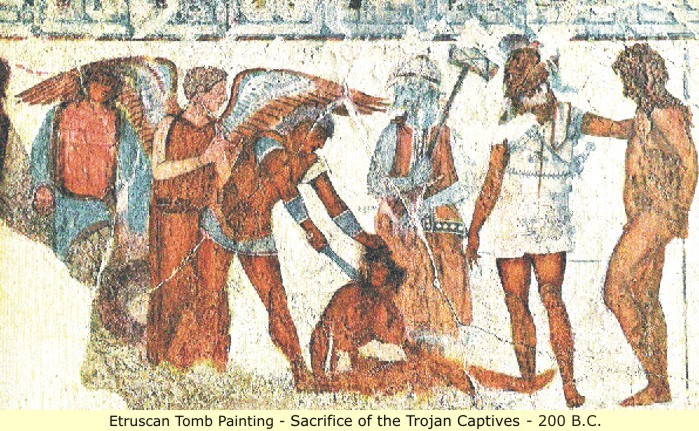 |
Roman myth is complicated by the early influence of Greek religion on the Italian peninsula during Rome's protohistory, and by the later self-conscious imitation of Greek literary models by Roman authors, who borrowed narratives of Greek deities reinterpreted as the counterparts of Rome's own pantheon. Rome's early myths and legends also have a dynamic relationship with Etruscan religion, less documented than that of the Greeks.
Some examples of Egyptian-to-Greek-to-Roman Mythology
| Egyptian | Greek | Roman |
| Amun | Zeus | Jupiter ("Zeus pater") |
| Hathor | Aphrodite | Venus |
| Khonsu | Heracles | Hercules |
| Isis | Demeter (Io) | Ceres |
| Osiris | Dionysus | Bacchus |
| Horus | Apollo | Apollo |
According to Greek myth Heracles was a divine hero, the son of Zeus and Alcmene, foster son of Amphitryon and great-grandson (and half-brother) of Perseus. He was the greatest of the Greek heroes, a paragon of masculinity, the ancestor of royal clans who claimed to be Heracleidae and a champion of the Olympian order against chthonic monsters. In Rome and the modern West, he is known as Hercules, with whom the later Roman Emperors, in particular Commodus and Maximian, often identified themselves. The Romans adopted the Greek version of his life and works essentially unchanged.
Alcmene was born to Electryon, king of Mycenae and a son of Perseus. Her mother was either Anaxo, daughter of Alcaeus and Astydamia, or Lysidice, daughter of Pelops and Hippodameia. Hesiod describes Alcmene as the tallest, most beautiful woman with wisdom surpassed by no person born of mortal parents. It is said that her face and dark eyes were as charming as Aphrodite's, and that she honoured her husband like no woman before her. She was the great-granddaughter of Zeus.
 |
According to Roman myth, Rome was founded by Romulus and his twin brother Remus, descendants of Aeneas, divinely fathered by Hercules on a virgin princess or priestess of Vesta, who was exposed to die, but saved by a series of miraculous interventions. They were eventually restored to their royal birthright but decided to found a new city for themselves and their followers. When they could not agree on its site, they used augury to seek the opinion of the gods. Romulus was sent the most favourable signs, and established a city on the Capitoline Hill, and created its sacred boundary; Remus insulted the new city and was killed. Romulus named the new city "Rome" after himself, appointed its first senate and organised its armies. Faced with a shortage of marriageable young women, he invented a religious festival, the Consualia, invited the neighbouring Sabines then kidnapped their daughters.
Each of Rome's legendary or semi-legendary kings was associated with one or more of the religious institutions familiar to the later Republic. Tullus Hostilius and Ancus Marcius devised the fetial priests and their rites. The first "outsider" Etruscan king, Lucius Tarquinius Priscus founded a Capitoline temple to Jupiter, Juno and Minerva which served as a later model for the highest official cult throughout the Roman world. The benevolent, divinely fathered Servius Tullius established the Latin League and built its Aventine Temple to Diana, and instituted the Compitalia to mark his social reforms. His arrogant successor (and murderer) Tarquinius "the Proud" was expelled, and Rome became a Republic, run by annually appointed consuls.
Correction to the lies of the White Mans History
Contrary to the racist revisionism of modern Whites: Rome, like Greece, was a multi-ethnic, multi-racial society. With many Black or mixed-race kings, Black Popes, Black Commanders, soldiers, sailors, and of course citizens. (Being mindful of the White mans propensity for manufacturing fake artifacts to show Whites, there is no guarantee that the following Busts are accurate). And of course, much of our current crop of Greek and Roman sculpture are 18th - 19th century creations. We oftentimes compare Coins with Busts to ascertain the truth. But unfortunately, Whites are also expert at creating perfect fake coins, which look like ancient coins, so there is no guarantee there either. The one saving grace, is that with Black kings, the fabricators will sometimes leave a hint of Blackness in the image, rather than making it appear pure White. Thus from that hint, we can extrapolate.
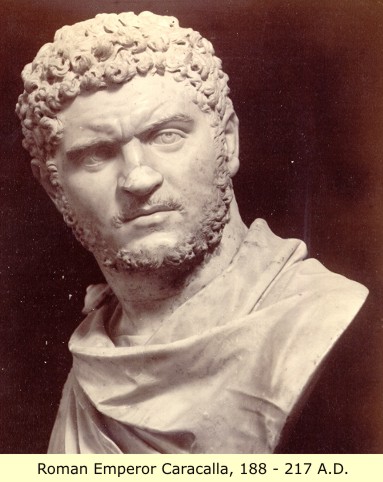 | 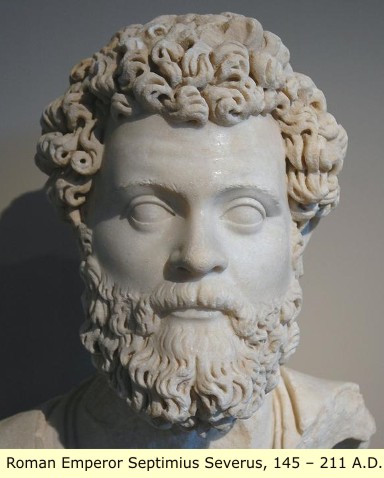 |
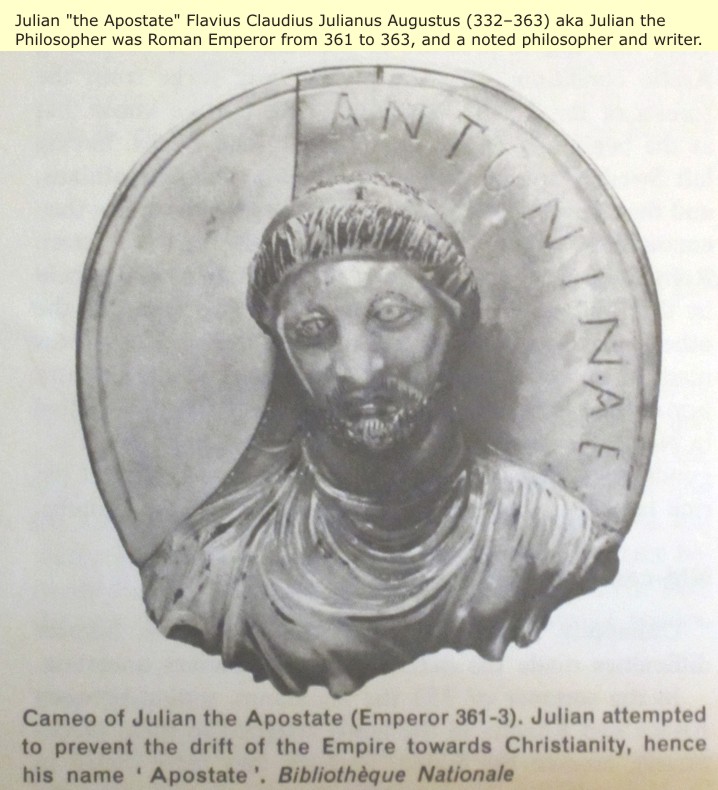 |
 |  |
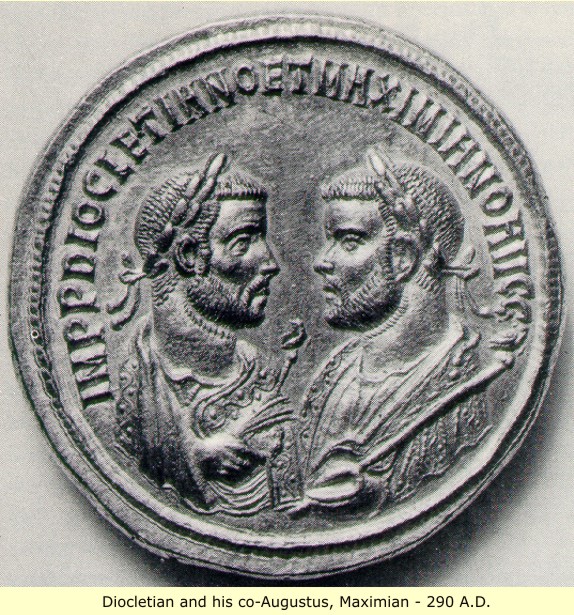 |
 |
 |  |
 |
 |
 |
 |  |
A perfect example of the difference between the White Mans History: and "Real" factual History!
 |  |
The legend of Saint Maurice and the Theban legion (circa 250 A.D.)St. Maurice was an Egyptian from Thebes in Upper Egypt, and General (primicerius) of the Theban Legion. The Theban legend relates that the legion, composed entirely of Christians, had been called from Thebes in southern Egypt, to suppress a revolt of the Bagandae (also Christians) in Gaul (now Saint-Maurice Switzerland). After victory, the soldiers were ordered to sacrifice (Bagandae prisoners?) to the gods in thanksgiving by Roman Emperor Maximian Herculius. But at Maurice’s urging, they refused. Every tenth soldier was then killed (decimation). Another order to sacrifice and another refusal caused a second decimation, and then a general massacre of the Legion. (A Roman legion was typically composed of perhaps 6,000 soldiers, divided into "cohorts" and further divided into "centuries").So reads the earliest account of their martyrdom, contained in the public letter of Eucherius, bishop of Lyon (434–450), addressed to his fellow bishop Salvius. Alternate versions have the legion refusing Maximian's orders only after discovering a town they had just destroyed had been inhabited by innocent Christians. And some have Maurice as a captain of the legion. This legend and its historical implications are a wonderful example of the pathetic racism and outrageous stupidity; of the nonsense Whites try to pass of as history. Lets deconstruct this nonsense for examination. First, Maurice is not an Egyptian name. Now lets look at the logistics of this: If Emperor Maximian was in Rome at the time he sent for Maurice, it would have taken a minimum of 32 days for the message to reach Maurice. It would have taken Maurice 15-30 days to gather up his 6,000 men and supplies for the journey. On his 80 day (armies travel slow) 2,000 mile journey to Switzerland he would have PASSED Rome. All told, 4-5 months have passed: the Bagandae couldn’t have been much of a threat, and Emperor Maximian must have been very weak militarily. So then, exactly who were the Roman troops with the strength to impose a decimation, and then a massacre, on Maurice’s 6,000 strong Army? Pure nonsense! Maurice is said to have the title of "Primicerius". But in the military, the use of the term was restricted to units associated with the imperial court, chiefly imperial guards. WHAT WOULD THE IMPERIAL GUARD BE DOING IN EGYPT? Worst yet logically - PERMANENTLY STATIONED THERE? Pure nonsense! Maurice died 287 A.D. Eucherius, Bishop of Lyon, discovered his story, and wrote about him in about 450 A.D. THEN about ONE THOUSAND years LATER: Whites SUDDENLY started making Statues and Paintings of Maurice in MEDIEVAL UNIFORM, not ROMAN UNIFORM! Pure nonsense! Why would Whites need to come up with such a ridicules story? Simple: they needed an explanation for the presence of a prominent Black man in Europe. There are just too many statues and paintings of him to hide or destroy, and replace with White depictions of him – as they usually do. So that ridicules story was the only way to explain his presence in Europe. Take note that they were careful to place his origin in Africa. Because as we all know, that is the only place Blacks were found in those days – according to the nonsense of Whites.So who was Maurice? Owing to the fact that he became the Patron saint of the Germany based, Holy Roman Empire: He was probably a Celt from what is now Germany. There were prominent others from that region with the same name, such as MAURICE, ELECTOR OF SAXONY (1521-1553). As a matter of fact, it may well be that the reason the "Supposed" Roman St. Maurice is ALWAYS depicted in "Medieval" uniform, rather than the correct Roman uniform of his time: is because those are actually depictions of MAURICE, DUKE and ELECTOR OF SAXONY! Black Saints are bad enough for the sick minds of Whites, no method is too extreme to conceal Black Dukes and Kings. |
Roman Citizens
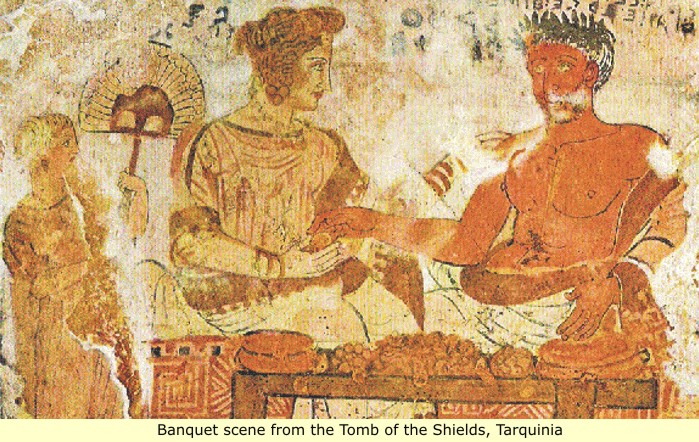 |
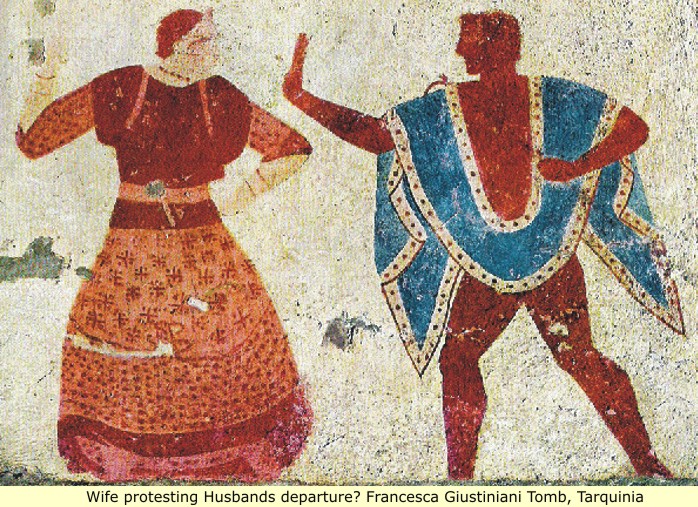 |
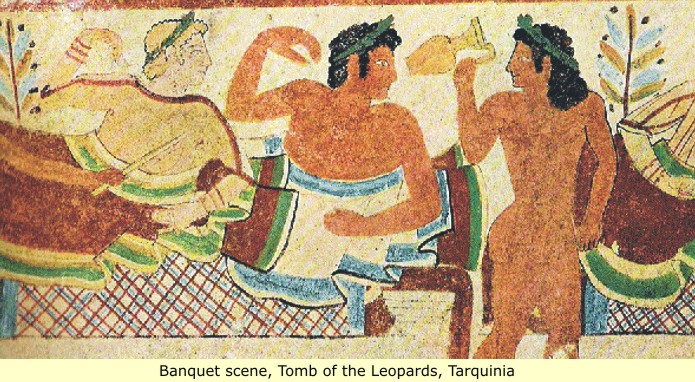 |
The Germanic's
also Slav's
The point has been made in these pages, many times, that modern Whites are derived from Central Asian Albinos, who invaded Europe in the early modern era. And that modern Whites have little relationship to Ancient Europeans, Greeks or Romans. To make this point, we quote "Cornelius Tacitus" (who was likely a Celt, 56 - 117 A.D.) He was a senator, and a historian of the Roman Empire: We quote from his book, The Germania (Latin: De Origine et situ Germanorum, literally Concerning the Origin and Situation of the Germanics).
Cornelius Tacitus, Germany and its TribesThe Germans themselves I should regard as aboriginal, and not mixed at all with other races through immigration or intercourse. For, in former times, it was not by land but on shipboard that those who sought to emigrate would arrive; and the boundless and, so to speak, hostile ocean beyond us (the north Sea), is seldom entered by a sail from our world. And, beside the perils of rough and unknown seas, who would leave Asia, or Africa, or Italy for Germany, with its wild country, its inclement skies, its sullen manners and aspect, unless indeed it were his home? In their ancient songs, their only way of remembering or recording the past, they celebrate an earth-born god, Tuisco, and his son Mannus, as the origin of their race, as their founders.The name Germany, on the other hand, they say, is modern and newly introduced, from the fact that the tribes which first crossed the Rhine and drove out the Gauls, and are now called Tungrians, were then called Germans. Thus what was the name of a tribe, and not of a race, gradually prevailed, till all called themselves by this self-invented name of Germans, which the conquerors had first employed to inspire terror. For my own part, I agree with those who think that the tribes of Germany are free from all taint of inter-marriages with foreign nations, and that they appear as a distinct, unmixed race, like none but themselves. Hence, too, the same physical peculiarities throughout so vast a population. All have fierce blue eyes, red hair, (classic Albinism), huge frames, fit only for a sudden exertion. They are less able to bear laborious work. Heat and thirst they cannot in the least endure; to cold and hunger their climate and their soil inure them. |
Decline of the Roman Empire

When Constantine became the sole Roman Emperor in 324, Christianity became the leading religion of the empire. After the death of Constantine in 337, two of his sons, Constantius II and Constans took over the leadership of the empire. Constans, ruler of the western provinces, was like his father, a Christian. In 341, he decreed that all pre-Christian Graeco Roman worship and sacrifice should cease; warning those who still persisted in practising ancient Graeco-Roman polytheism with the threat of the death penalty.
Lay Christians took advantage of new anti-Graeco-Roman polytheism laws by destroying and plundering the temples. Temples that survived were converted into Christian churches: the Pantheon is the most notable example, having once been a temple to all the gods and later, removing the statues of the so-called 'pagan' gods and replacing them with Christian saints, becoming a church in honor of their own one god. Many of the buildings in the Roman Forum were similarly converted, preserving the structures if not their original intent.Later on, the emperor Julian the Apostate attempted to reverse the process of Christianization and bring back the native forms of polytheism, but his death in Persia caused the empire to once again fall under the power of Christian control, this time permanently.

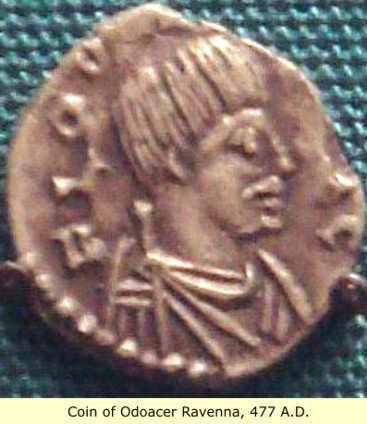
The decline of the Roman Empire was a slow process, which occurred over a period of over 350 years. Beginning at about 100 A.D. and culminating on September 4, 476, when Romulus Augustus, the last Emperor of the Western Roman Empire, was deposed by Odoacer, a Germanic chieftain.
Though by appearance, Odoacer was probably a Celt/Gaul: they being the original people of Germany. With the actual true (White) Germaic's following. Note that Odoacers hair stands straight up, White peoples hair cannot do that naturally. (Laugh at the example if you will, but the point still holds true, also note Vercingetorix's hair).
Charlemagne
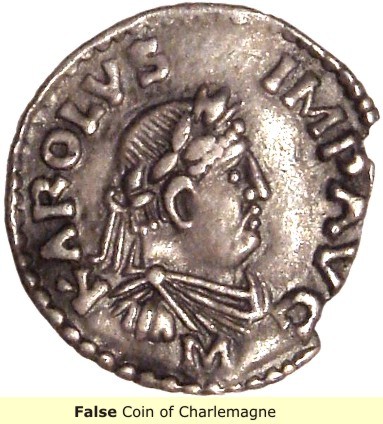
Rome's replacement "The Holy Roman Empire" was a realm that existed for about a millennium in West and Central Europe: ruled by a Holy Roman Emperor. Charlemagne (meaning Charles the Great; possibly 742 – 28 January 814 - King of the Franks). He expanded the Frankish kingdom (France) into an empire that incorporated much of Western and Central Europe. During his reign, he conquered Italy and was crowned Imperator Augustus by Pope Leo III on 25 December 800 A.D. This temporarily made him a rival of the Byzantine Emperor in Constantinople. His rule is also associated with the Carolingian Renaissance, a revival of art, religion, and culture through the medium of the Catholic Church. Through his foreign conquests and internal reforms, Charlemagne helped define both Western Europe and the Middle Ages.
He is numbered as Charles I in the regnal lists of Germany (where he is known as Karl der Große), the Holy Roman Empire, and France. He was crowned Emperor of the Romans in 800 A.D. and was then the forerunner of the Holy Roman Emperors, largely because he had inaugurated the tradition of imperial coronation by the Pope of the Catholic Church. This continued as a significant institution in the Holy Roman Empire until the 16th century. In a decree following the 1512 Diet of Cologne, the name was officially changed to Holy Roman Empire of the German Nation. Charlemagne's policy of "renovatio Romanorum imperii" (reviving the Roman Empire) remained at least in theory, as the official position of the Empire until its end in 1806.
Was Charlemagne a Black man? At this point there is no way to know - and that information is not likely to be forthcoming. But it appears that contrary to what Whites say, the Franks were probably a "Native" NOT Germanic people. As such, Charlemagne would have indeed, probably been a Black man. But because Whites have so interwoven European history with lies, there are really no safe assumptions, and no safe place to start.
As to the false Coin: In 1861, Charlemagne's tomb was opened by scientists who reconstructed his skeleton and estimated it to be measured 74.9 inches (190 centimeters). A modern study based on the dimensions of his tibia estimate his height as 1.84 m. This puts him in the 99th percentile of tall people of his period given that average male height of his time was 1.69 m. The width of the bone suggest he was gracile not robust in body build. So at least one thing we know for sure: that COIN image is NOT of Charlemagne. But what's new, Whites routinely use fake artifacts to bolster their lies. Charlemagne was actively and personally involved in wars into distant lands throughout his 46 year reign - Fat guys don't get around like that! So whoever decided to falsely use that coin, didn't even know the history of the man.
But there is no ambiguity about Charlemagne's successor as Holy Roman Emperor: Otto I, he was most certainly a Black man!
Holy Roman Emperor: Otto I
 |
Note: Otto I is the Black Freising King on the "Coat of Arms" of the current Pope: Pope Benedict XVI, who is of German extraction.
 |
 Otto I, the Great (23 November 912 in Wallhausen – 7 May 973 in Memleben), son of Henry I the Fowler and Matilda of Ringelheim, was Duke of Saxony, King of Germany, King of Italy, and "the first of the Germans to be called the emperor of Italy" according to Arnulf of Milan. While Charlemagne had been crowned emperor in 800, his empire had been divided amongst his grandsons, and following the assassination of Berengar of Friuli in 924, the imperial title had lain vacant for nearly forty years. Otto succeeded his father as king of the Saxons in 936, on February 2, 962, Otto was crowned Emperor of what would later become the Holy Roman Empire.
Otto I, the Great (23 November 912 in Wallhausen – 7 May 973 in Memleben), son of Henry I the Fowler and Matilda of Ringelheim, was Duke of Saxony, King of Germany, King of Italy, and "the first of the Germans to be called the emperor of Italy" according to Arnulf of Milan. While Charlemagne had been crowned emperor in 800, his empire had been divided amongst his grandsons, and following the assassination of Berengar of Friuli in 924, the imperial title had lain vacant for nearly forty years. Otto succeeded his father as king of the Saxons in 936, on February 2, 962, Otto was crowned Emperor of what would later become the Holy Roman Empire.| Click Here for more on Black British Royalty: Click >>> |
In order to seal an alliance between two Saxon kingdoms, her half-brother, King Athelstan of England, sent two of his sisters to Germany, instructing the Duke of Saxony (later Otto I, Holy Roman Emperor) to choose whichever one pleased him best. Otto chose Edith and married her in 929. The remaining sister Algiva or Adiva was married to a "king near the Jupiter mountains" (the Alps). The precise identity of this sister is debated. She may have been Eadgifu of England, who married King Charles III of France, or another sister otherwise unknown to history.
As queen, Eadgyth undertook the usual state duties of a Queen: when she turns up in the records it is generally in connection with gifts to the state's favoured monasteries or memorials to female holy women and saints. In this respect she seems to have been more diligent than her now widowed and subsequently sainted mother-in-law Queen Matilda whose own charitable activities only achieve a single recorded mention from the period of Eadgyth's time as queen. There was probably rivalry between the Benedictine Monastery of St Maurice founded at Magdeburg by Otto and Eadgyth in 937, a year after coming to the throne and Matilda's foundation at Quedlinburg Abbey, intended by her as a memorial to her husband, the late King Henry I. Like her brother, Athelstan, Edith was devoted to the cult of Saint Oswald and was instrumental in introducing this cult into Germany after her marriage to the emperor. Her lasting influence may have caused certain monasteries and churches in Saxony to be dedicated to this saint.
Eadgyth died at a relatively young age. Her tomb is located in the Cathedral of Magdeburg, Germany. A lead coffin inside a stone sarcophagus with her name on it was found and opened in 2008 by archaeologists during work on the building. An inscription recorded that it was the body of Eadgyth, reburied in 1510. It was examined in 2009, then brought to Bristol, England, for tests in 2010. Professor Mark Horton of Bristol University said that "this may prove to be the oldest complete remains of an English royal."
Edith and Otto's children were: 1. Liutgarde, married Conrad the Red, 2. Liudolf, Duke of Swabia (930-September 6 957)





No comments:
Post a Comment